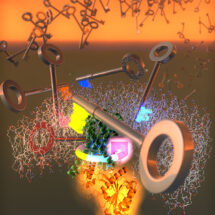
G protein-coupled receptors (GPCRs) form the largest family of membrane-protein receptors and drug targets. With over 800 different family members in humans, GPCRs regulate diverse intracellular signalling cascades in different cell types, tissues and organ systems. Whilst GPCRs sense a plethora of environmental stimuli, the appropriate cellular response is primarily triggered by binding to four major Gα protein families encoded by 16 human genes. Therefore, the selective coupling of a ligand-activated GPCRs to appropriate Gα proteins is critical for signal transduction. Despite considerable progress studying individual receptor-G protein complexes, determining the molecular basis of selective binding has been a challenging problem. Recent research spearheaded by Tilman Flock in Madan Babu’s group in the LMB’s Structural Studies Division, in collaboration with David Gloriam’s group at the University of Copenhagen, shows the molecular details of how different GPCRs selectively activate distinct G proteins to trigger specific signalling pathways.
The team has revealed a ‘selectivity barcode’ (i.e. patterns of amino acids) on different G proteins. These barcodes are selectively recognised by distinct GPCRs. Using ancestral reconstruction of the evolutionary history of GPCRs and large sequence alignments made by Balaji Santhanam at the LMB, the team found that different receptors have evolved unique solutions to read the G protein barcodes. In other words, the different receptors appear to use different sequence patterns to read the same barcode on the G protein. This has striking analogy to a complex system of multiple keys and locks, where GPCRs are keys and the G proteins are locks that open different doors – the signalling pathways. The pattern of grooves and ridges on the lock, the G protein interface, allows the design of different keys that open the same lock. Thus, while the G proteins have been conserved throughout evolution, new organism-specific GPCRs have dynamically evolved to couple to an existing G protein and trigger specific signalling pathways. These findings are highly significant as they explain how such a protein interaction interface could have facilitated the rapid evolution of the GPCR signalling system and contributed to organismal complexity by allowing cells to respond to different stimuli and thereby permitting adaptation to diverse environments.
GPCR-mediated signalling pathways are important for a broad range of processes such as regulation of the immune system, neurotransmission, vision, taste, and smell. Misregulation of GPCR signalling causes a number of diseases, ranging from cancer and infertility, to various inherited endocrine disorders. Currently, 30% of all prescribed drugs on the market target GPCR signalling. The findings from this work, along with an extensive web resource within the GPCRdb community database that was developed by Alexander Hauser in Gloriam’s group, will serve as a roadmap for scientists from diverse research areas. This research provides a molecular understanding of how GPCR drugs act and could help to design drugs with fewer side effects. It also lays the foundation to study selectivity of different human receptors.
The work was funded by the MRC, the Boehringer Ingelheim Fond, European Research Council, the Lundbeck Foundation, Fitzwilliam College, University of Cambridge and a Lister Institute Research Prize.
Further references:
Paper in Nature
Madan’s group page
David Gloriam’s group page
GPCRdb web resource (tab: signal proteins)
Previous Insight on Research article: Revealing how GPCRs activate Gα proteins